
 Earlier this month, worldwide Human Rights organization Amnesty International released a news article on the plight of Sikh Massacre victims of 1984, still awaiting justice after 25 years. This came shortly after the Delhi Court delayed ruling on Jagdish Tytler, due to the CBI’s inability to produce enough evidence against him. Ramesh Gopalakrishnan, Amnesty International’s South Asia Researcher stated:
Earlier this month, worldwide Human Rights organization Amnesty International released a news article on the plight of Sikh Massacre victims of 1984, still awaiting justice after 25 years. This came shortly after the Delhi Court delayed ruling on Jagdish Tytler, due to the CBI’s inability to produce enough evidence against him. Ramesh Gopalakrishnan, Amnesty International’s South Asia Researcher stated:
“The fact that almost 3,000 people can be murdered without anyone being brought to justice is offensive to any notion of justice and should be an embarrassment to the Indian government.”
“For the Indian government to dismiss these cases due to lack of evidence is farcical. The various agencies responsible for carrying out the investigations failed to carry out the most cursory of tasks – including recording eyewitness and survivor statements.”
As troubling as it is to read this, I was pleased to find that Amnesty International had covered it at all. As many of know, AI, as well as other independent human rights groups and initiatives were either banned or prevented from conducting research in India in the late 1980’s and early 1990’s. It seems as though there is hope for an independent investigation on the 1984 anti-Sikh pogroms and perhaps the subsequent disappearances during the counter-insurgency.
Not so fast…in an un-related story, the Tribune reported that Amnesty International has decided to shut down its India operations. The decision is said to have been triggered by continued denial to the Amnesty International Foundation of the FCRA (Foreign Contribution Regulation Act) registration by the Government of India.
Continue Reading »
 Sometimes some articles are too disturbing to not make a comment.
Sometimes some articles are too disturbing to not make a comment.
The word Mein Kampf immediately brings to mind Adolf Hitler’s deluded dream and genocidal paranoia of the “Jewish peril”. Long the Bible of idiotic Aryan supremacist groups, the book seems to have found a rather new (or maybe) old niche market in India.
Sales of Mein Kampf, Adolf Hitler’s autobiography and apologia for his anti-semitism, are soaring in India where business students regard the dictator as a management guru.
Booksellers told The Daily Telegraph that while it is regarded in most countries as a ‘Nazi Bible’, in India it is considered a management guide in the mould of Spencer Johnson’s “Who Moved My Cheese”.
Sales of the book over the last six months topped 10,000 in New Delhi alone, according to leading stores, who said it appeared to be becoming more popular with every year.
On TLH we have posted on the importance of Punjabi/Khalsa Schools. I have found that despite many students’ resistance to attend these schools, they plant the seeds for future exploration into Sikhi. At the age of 12 you may think you are too cool for school on Sundays, but at 19-20 or even 30 that experience creates a base for you to delve more deeply into your spiritual identity. Thus, I think it is extremely important that each Sikh community have at least one good Punjabi/Khalsa school. Ideally, I would want each Gurdwara to have one.
However, Punjabi/Khalsa Schools run into problems because in some way or another they become linked with communal politics. Most often this politics infiltrates schools within Gurdwaras. I think a fundamental component of a Gurdwara is a Punjabi/Khalsa School as is a Langar Hall. However, for many Gurdwaras, Punjabi/Khalsa Schools are a last priority. Gurdwara committees will fund new kitchen appliances before making a commitment to continually fund a Punjabi/Khalsa School. Thus, some community members have decided to create Punjabi/Khalsa Schools outside of the Gurdwara in local community-centers. When I hear this, I am both excited and disappointed. Excited that a school has been established; but disappointed that we are showing Sikh youth that we have to step outside of our main institution, the Gurdwara. How are we supposed to socialize our children into a Gurdwara-going culture when our leadership doesn’t support it in action? It’s a Catch 22. I don’t blame community members for creating schools outside of the Gurdwara. Their circumstances are real and, many times, this is their only feasible option. Or is it?
Today, I want to share with you, Nirpreet Kaur’s story. I highlight her story for 2 reasons. 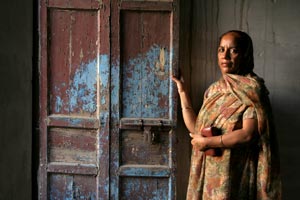
First, as we’ve discussed on this blog before, the majority of Sikh history as its been documented thus far really is his-tory. So this piece of her-story is a rare gem. And second, too often, we think of women in the Sikh community only in our roles as mothers, sisters, wives, and daughters. These are all important roles but our identity isn’t entirely defined relative to others’ or based on our relationships with others. Yet we recognize the additional roles we play outside of these expected roles too rarely. And so… Nirpreet Kaur.
Nirpreet was 16 years old on November 2, 1984 when the mob came for her father, Nirmal Singh…”[Khokhar- a Youth Congress leader] sweet-talked my father into coming with him for a compromise,” says Nirpreet. But Khokhar went straight to the mob and handed Nirmal Singh over. The oldest of three siblings, Nirpreet, ran to the mob but could only watch helplessly as her father was tied up and set ablaze. [link]
To avenge the killing of her father, Nirpreet joined the Khalistani movement.
As a functionary of the then dreaded All India Sikh Students Federation, Nirpreet came in contact with those involved with the Khalistan movement, an armed insurgency fighting for an independent Sikh homeland in Punjab, and became part of the militancy that ravaged the state for over a decade in the 1980s.[link]
One of the underlying issues to many of the discussions we have here on TLH seems to focus upon whether or not elements of Sikhi are being redefined as we evolve in the communities within which we reside. We often take concepts such as Seva, Sangat and Simran for granted without wondering if they are being fulfilled in their true element. I post on this topic not to argue whether or not what we do is right or wrong – but rather in what forms we see these concepts exist today.
In the midst of this world, do seva, and you shall be given a place of honor in the Court of the Lord. SGGS p26
One example that comes to mind is how gurdwaras and the sangat (I include myself in this sangat) have essentially ‘outsourced’ the kitchen seva. Each time I have visited one of the gurdwaras in my area, I notice that the sangat departs after eating langar, leaving behind a kitchen full of dirty pots and pans. This does not seem to be an issue because many gurdwaras have now hired help to come in and essentially do the seva. I understand the gurdwara’s reason for hiring help (the dishes have to get done) but I wonder how we got to this point. I’m not sure if this is an issue unique to North America or whether it occurs in India and also in the UK, for example. During my last few visits to gurdwaras in India, I was so impressed by the amount of seva that was occuring in the kitchen and was also inspired by the energy that was produced from the sangat working selflessly towards a similar goal.
 With Obama’s move for a new strategy, recently, we have seen an avalanche of different articles from Af-Pak, the newly vogue name for the region. I will begin with some more macro-debates, before turning to the Sikh-specific.
With Obama’s move for a new strategy, recently, we have seen an avalanche of different articles from Af-Pak, the newly vogue name for the region. I will begin with some more macro-debates, before turning to the Sikh-specific.
An interesting analysis was recently featured in the London Review of Books, in an article titled ‘Taliban versus Taliban.’ In the article, the Economist correspondent, Graham Usher, notes that Americans have a problem in understanding the complexities of the “Taliban” phenomenon because it means different things to different people at different times.
All politics is local and that is how the Taliban should be treated as well. Made up of diverse factions and groups with widely separate ideologies, we “lump” them under a specific tag – “Taliban.” While for the US, anyone that attacks them in Afghanistan is Taliban, for the Pakistani Army, their perspective is a bit different. The only issue that really matters is if the group works in India’s strategic interest. Thus there are ‘good’ elements and ‘bad’ elements:
The short answer is pro-India, in practice if not intent. Insurgents in the tribal areas are deemed anti-Pakistani if their actions advance the perceived goals of India in Afghanistan. They are pro-Pakistani as long as they don’t attack the Pakistani state or army, even if they launch attacks against Nato forces in Afghanistan, Islamabad’s supposed allies in the ‘war on terror’. Indeed, the Afghan Taliban is considered an ‘asset’, a hedge against the day when the US and Nato leave, but also a counter to India’s expanding influence in Afghanistan.
Updated: Friday, at 11:30PM
Last year we covered the story of a Sikh youth accused of brandishing his kirpan on the schoolyard. Accounts of the incident were hugely divergent; it was unclear whether an assault had ever actually occurred, or whether the report was a feature of animosity toward religious minorities in Quebec.
Yesterday that youth was fully acquitted of the kirpan-based charge, and his other possible charges were dispensed. The outcome of this case is a success for the youth involved, but also in that its outcome has no bearing on the interpretation or application of its effect to the kirpan in general. The judge in this case intimated that the case had gone too far and would never have been brought, were it not for the youth’s nationality and religious identity:
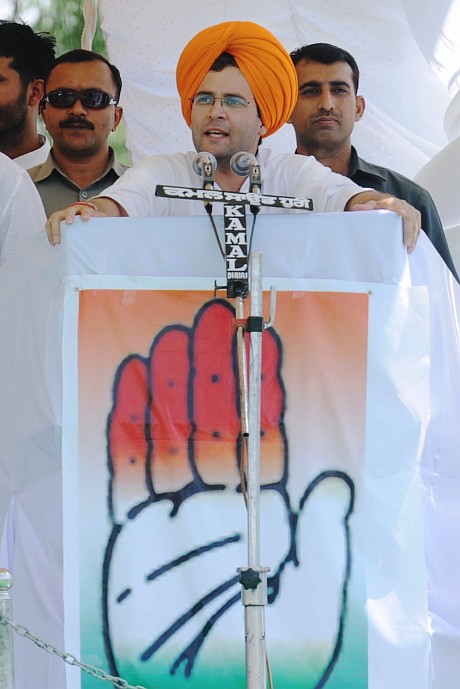 OR HOW NOT TO PULL A SIKH-RELATED PUBLICITY STUNT
OR HOW NOT TO PULL A SIKH-RELATED PUBLICITY STUNT
I will leave the PR-stunt by Congress heir-apparent, Rahul Gandhi, son of Rajiv Gandhi, grandson of Indira Gandhi, and great-grandson of Nehru and his ill-advised (or rather ill-positioned pagri) to speak for itself. A pictures is worth 1000 words and ‘ridiculous’ is one of those that come near the top for this election stop near Takht Damdama Sahib.
On a bit of a serious note, although I hate writing short posts without analysis, I came across a finely-written article about the ‘Shoe-hurling Sardar and Deep-rooted Sikh Grievances‘ published in a Pakistani newspaper that I wanted to bring to our readers’ attention.
I initially cringed when I read stereotypical sentences, such as:
However, Sikhs are known for their forthrightness and carrying a level head in emotionally charged situations is not one of their strengths.
Eventually I got over it and just focused on the substance of the matter. Definitely worth a read.
For my previous coverage, see here and here.
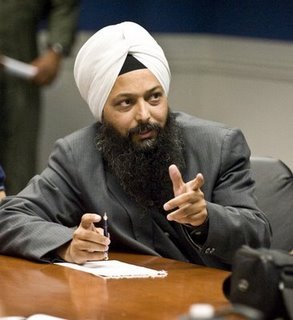 Last week, we saw the birth of a new Sikh folk hero. I am sure the dhadhi jathas (just as Chuck D called rap music the CNN of black people, dhadhi jatha is the CNN of the Sikhs) are already warming up their sarangi and dhad.
Last week, we saw the birth of a new Sikh folk hero. I am sure the dhadhi jathas (just as Chuck D called rap music the CNN of black people, dhadhi jatha is the CNN of the Sikhs) are already warming up their sarangi and dhad.
While other commenters have suggested material reasons for the turnabout in the Congress Party’s decision, I still contend that we must celebrate the Sikh masses for galvanizing the issue. The show of force came through Sikhs and their ‘rail roko’ with the shutting down of the railroad system throughout Punjab.
Although I am well aware of the political advantages that the Akali Dal and BJP sought to gain from the issue of the Delhi Pogroms of 1984, I hope for naysayers, worst of all those within our community, that like to state “the past is the past” and “let bygones be bygones” they realize the past does affect the present and life still does reside within the Sikh masses and polity.
Our so-called “leaders” rarely lead. Throughout Sikh history, it has been the masses that have had to goad these so-called leaders. Whether it was the movement to free the Gurdwaras from British-Mahant control during the early part of the 20th century or even the Sarbat Khalsa and subsequent declarations at the Akal Takht in 1986, the Sikh masses have always been the main impetus of the Qaum. The Guru Granth Sahib is our guide and the Guru Khalsa Panth (and not individual leaders, be they SAD Presidents or Jathedars) is our temporal collective body.
A few months ago, with our first TLH book club, Jodha blogged about Sikhs In Britain. The book was a fascinating insight into how the lives of Sikhs living in England have been shaped over generations. In a similar attempt to historically document the Punjabi Sikh community in the UK, The Southall Story is a project that celebrates a town that has “welcomed new communities throughout the last century, enabling them to excel and influence both the social and political structures of this country.” Through a series of public events, performances, exhibitions and forums, the project aims to educate and inspire people about their heritage.
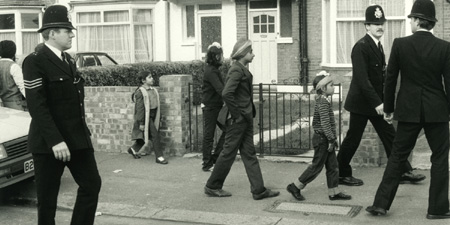
Southall is also a place that has come to be affectionately known as Little India, but for many it is much more than that. Being a port, (Heathrow is a stones throw away), Southall has been a home to such diverse groups as the West Indians, Indians and Pakistanis in the 50’s through to the Ugandan Asians in the 70’s. Most recently, new arrivals include Sikhs from Afghanistan and Somalians.
These settlements invariably have influenced and shaped Southall. Pivotal moments such as the racist murder of teenager Gurdip Singh Chaggar in 1976… meant that as a community issues of race and gender could no longer be avoided. [link]
As we remember 1984 through concerts and acts of rebellion, let’s not forget the visceral spirit displayed by Singhs IN that time period.
Watch below the original version of a Punjabi kavita sung by Bhai Gursharan Singh during those turbulent times in Manji Sahib Hall located in the Darbar Sahib complex . This kavita captures the mood and spirit of those days. Tigerstyle later used it in one of their Shaheedi CDs to REMEMBER that spirit.
Intellectually, we can try to REMEMBER those days; but this kavita actually makes us FEEL how it was to live through that time.

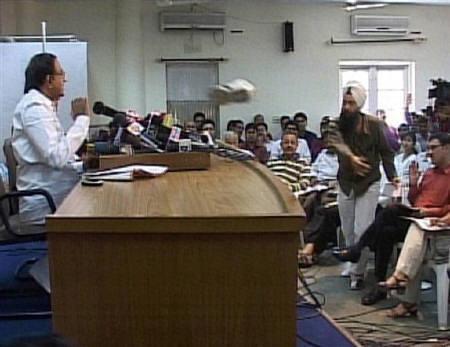 I know many will object to this post and ask how does a shoe bring justice to the thousands that lost their lives in 1984? My reply – it doesn’t.
I know many will object to this post and ask how does a shoe bring justice to the thousands that lost their lives in 1984? My reply – it doesn’t.
But what it does do is highlight the farce that calls itself Indian justice.
Earlier this week, I wrote about Sikh outrage against the Congress Party’s continuance of giving electoral posts to genocidal murders. While I still hold my claim of an independent position against Parkash Badal, the Akali Dal, and the BJP’s opportunism and the Congress Party’s celebration of impunity, the action of journalist Jarnail Singh warrants commentary and analysis.
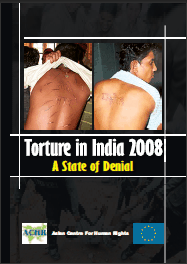 I recently stumbled on a report from the Asian Centre for Human Rights (ACHC), titled Torture in India 2008: A State of Denial. This document claims to be “the first nationwide assessment of the use of torture in India.”
I recently stumbled on a report from the Asian Centre for Human Rights (ACHC), titled Torture in India 2008: A State of Denial. This document claims to be “the first nationwide assessment of the use of torture in India.”
ACHC is a Delhi-based organization focused on protecting human rights throughout Asia, with what appears to be a specific focus on South Asia. I’m not familiar with this organization, so I’d be curious to hear if others can support or disprove their work.
The report focuses on the use of torture by police and security forces from routine arrests to counter-insurgency operations. Although it is clearly a preliminary analysis, it’s findings are quite alarming. The report notes:
The statistics of NHRC imply that in the last five years 7,468 persons at an average of 1,494 persons per year or four persons in a day died in police and prison custody in India. However, these figures represent only a fraction of the actual cases of torture. Cases of torture not resulting in death are not recorded.
Particularly troublesome was the section on custodial torture of women and children.
 As previously discussed, 1984 continues to haunt the psyche of a new generation of Sikhs. As justice continues to be denied to those that faced the Sikhs’ Kristallnacht in Delhi, the perpetrators of the heinous pogroms continue to roam the streets with impunity and some even continue to be awarded ministerial and cabinet positions by the government.
As previously discussed, 1984 continues to haunt the psyche of a new generation of Sikhs. As justice continues to be denied to those that faced the Sikhs’ Kristallnacht in Delhi, the perpetrators of the heinous pogroms continue to roam the streets with impunity and some even continue to be awarded ministerial and cabinet positions by the government.
With the upcoming elections in India, Jagdish Tytler has been nominated by the Congress Party to run for the Lok Sabha Member of Parliament (MP) in northeast Delhi.
The Jathedar of the Akal Takht, Gurbachan Singh, and SGPC officials have called for a protest outside the residence of Congress Party president, Sonia Gandhi.
No Sikh should think that the call could have been given by the Jathedar without the expressed permission of Parkash Badal and that too for electoral gain. Kaka Badal, Sukhbir Badal, has already used the issue to call for Congress Party head, Captain Amrinder Singh (scion of the house of Patiala) to resign from his position.
Last week, I posted on the Gurmat Gian Group’s performance of classical keertan. This all Sikh women’s group, expect 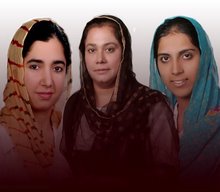 for a tabla player, is based in Ludhiana, Punjab. This week, I wanted to share a brief interview with one of its members, Keerat Kaur.
for a tabla player, is based in Ludhiana, Punjab. This week, I wanted to share a brief interview with one of its members, Keerat Kaur.
1. How did you come to join the Gurmat Gian Group? How long have you been with the group? How often does the group meet?
The Gurmat Gian Group was formed by my mother Gurpreet Kaur. My mother Gurpreet Kaur and myself used to do kirtan in the weekend gatherings of Gurmat Gian Missionary Trust. These programmes are held every Saturday and Sunday. Impressed with our singing, we were asked by the organizers and especially by Rana Inderjit Singh to train young boys and girls to do kirtan. Now Gurpreet Kaur takes regular classes at the Gurmat Gian Missionary College where many girls and boys of different age groups are learning kirtan.
Encouraged to go in to recording Gurabni Kirtan lead to the formation of Gurmat Gian Group which now has 5 CDs to its credit.
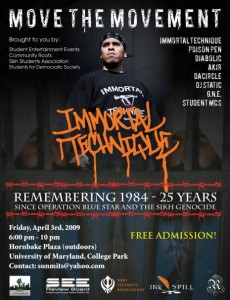 I know this concert has already been discussed, but the event had been postponed to this coming Friday…and with all the local buzz…it got me thinking about how we remember 1984.
I know this concert has already been discussed, but the event had been postponed to this coming Friday…and with all the local buzz…it got me thinking about how we remember 1984.
The Sikh Student Association here at the University of Maryland, in conjunction with other student groups, is sponsoring a free concert on April 3rd, 2009 to mark the 25th anniversary of the 1984 Sikh genocide. In a previous post Truth To Power – in reference to the recent Ensaaf report, I had stated:
We must read such reports and present them … anywhere and everywhere … to anyone who will listen: our gurdwaras, our local Amnesty International chapters, student groups, talk radio, public television, newspaper op-eds, etc. We must also create awareness of these findings in whatever format we can – through music, art, theatre and poetry.
The featured performer for the concert is Immortal Technique, an up-and-coming rapper who attracts a large and diverse audience, especially amongst college students. His intense style, controversial lyrics, and willingness to approach political subjects, such as the mid-east conflict, have made him a fan favorite amongst the politically aware.
It is refreshing to see students think “out-of-the-box” in remembering 1984, by attracting a mainstream artist and joining forces with other student activist groups under the tagline “Move the Movement.” The SSA plans to distribute background material on the 1984 atrocities and subsequent human rights violations, as well as feature short video clips and interviews with victims in between acts.
Radio Free Afghanistan 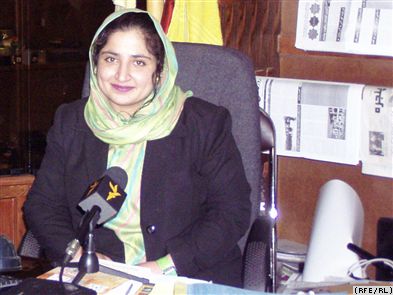 just chose Anarkali Honaryar for their “Person of the Year” award. Coincidentally, Anarkali is a member of Afghanistan’s minority Sikh community. At 25 years old, Anarkali is also a physician, a human rights activist, a member of Afghanistan’s Constitution Committee, and works for the Independent Human Rights Commission of Afghanistan. Oh, and she finished high school at 12.
just chose Anarkali Honaryar for their “Person of the Year” award. Coincidentally, Anarkali is a member of Afghanistan’s minority Sikh community. At 25 years old, Anarkali is also a physician, a human rights activist, a member of Afghanistan’s Constitution Committee, and works for the Independent Human Rights Commission of Afghanistan. Oh, and she finished high school at 12.
Wow. I think another fitting title would be Sikh Role Model of the Year (or the decade?). She has definitely just become my role model. And we can definitely add her to our list of sheroes.
Just what exactly was Anarkali given this award for?
She is well-known for helping women who suffer from domestic abuse, forced marriages, and gender discrimination. Honaryar is also an advocate on behalf of Afghanistan’s small, embattled Hindu minority, which lives in squalid conditions and faces harassment and discrimination. “We are thrilled to recognize Anarkali for her tireless work in promoting democracy, human rights, and civil society in Afghanistan,” said Radio Free Afghanistan Director Akbar Ayazi. “Anarkali has been taking part in Afghanistan’s reconstruction since she was a teenager — this recognition is well-deserved.” [Radio Free Europe]
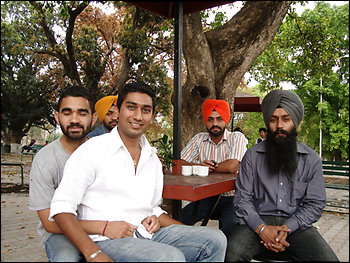 The story is hardly new. Every few weeks, we see reports by journalists that reinforce a well-known reality – many Sikh men in Punjab are cutting their hair and removing their turbans. I am hardly an alarmist. I do believe that despite the overwhelming trend, there are countercurrents as well. In an earlier post, I described what I have termed a ‘Sikh turn’.
The story is hardly new. Every few weeks, we see reports by journalists that reinforce a well-known reality – many Sikh men in Punjab are cutting their hair and removing their turbans. I am hardly an alarmist. I do believe that despite the overwhelming trend, there are countercurrents as well. In an earlier post, I described what I have termed a ‘Sikh turn’.
Although many Sikh youths have for the time being removed their turbans, their sense of a religio-ethnic identity still remains strong. Maybe the temptations of modernity and especially the desires of the opposite sex are strong and many feel that at this point in their life they would rather pursue women and cannot live up to the great ideals of their Gurus. This should not be read as a rejection of those ideals but a realization of where they are and their priorities at this time. (Though this may be the case of those that remove their pagri on their own account and not in those families and children where they never had it as many in the diaspora)
As discussed previously, the ‘Sikh turn’ is occurring. The psychological tragedy of the post-1993 Sikh community is beginning to wane and we may be witnessing the dawn of a new era. It may not be in the Khalsa symbolic form that many hope, but a religio-ethnic movement is occurring. The youth are not disinterested and disconnected; they are engaged and can be mobilized. The pull of the pagri is not dead in Punjab either as we see many Bihari migrants joining the Qaum’s ranks. This is a good sign. A new generation will soon have its own version of ‘pagri sambhal jatta.’[link]
A recent article in the Washington Post revisits the issue, highlighting a looming impending court case.
Recently we have discussed gurmat sangeet (i.e. classical keertan) on TLH. This past week, I came across an all Sikh women’s gurmat sangeet group from Punjab. Their voices are absolutely beautiful! The emotion that raags convey that words alone cannot express is actually felt in these women’s performances. You can visit the Gurmat Gian Group blog here. They also have a youtube channel here.
Here is their performance of the shabad, “Sur Nar Mun Jan Amrit Khojday”.

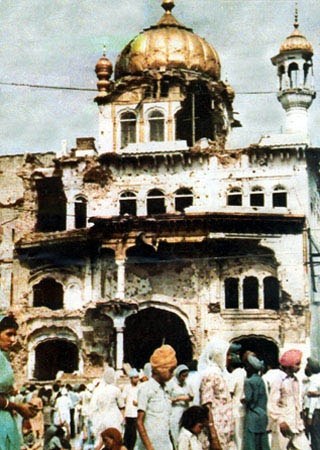 In time for the beginning of the Sikh New Year according to our own Nanakshahi calendar, the Shiromani Gurdwara Parbhandak Committee (SGPC) has released its annual calendar. In this 25th year of remembering the events of 1984, it is a moment for Sikhs to reflect and take lesson as well as maybe something for India to reflect and takes lesson as well (hopefully not the so-called morally-bankrupt, heinous ‘Punjab lesson.’)
In time for the beginning of the Sikh New Year according to our own Nanakshahi calendar, the Shiromani Gurdwara Parbhandak Committee (SGPC) has released its annual calendar. In this 25th year of remembering the events of 1984, it is a moment for Sikhs to reflect and take lesson as well as maybe something for India to reflect and takes lesson as well (hopefully not the so-called morally-bankrupt, heinous ‘Punjab lesson.’)
This year’s calendar includes a picture of the Akal Takht, bullet-ridden and tank-bombed, after the Battle of Amritsar. The call for SGPC recognition has been long overdue. Activists within the Sikh community have been calling for official recognition of the Third Sikh Genocide (Third Ghallughara) for years. Finally the SGPC has taken action.
Unfortunately, the SGPC does not act at the behest of the community, but only at the behest of Badal. In an election year, many are seeing the picture’s inclusion as an attempt by the Akali Dal (Badal) to play upon Sikh public sentiments against the Congress Party in Punjab.
